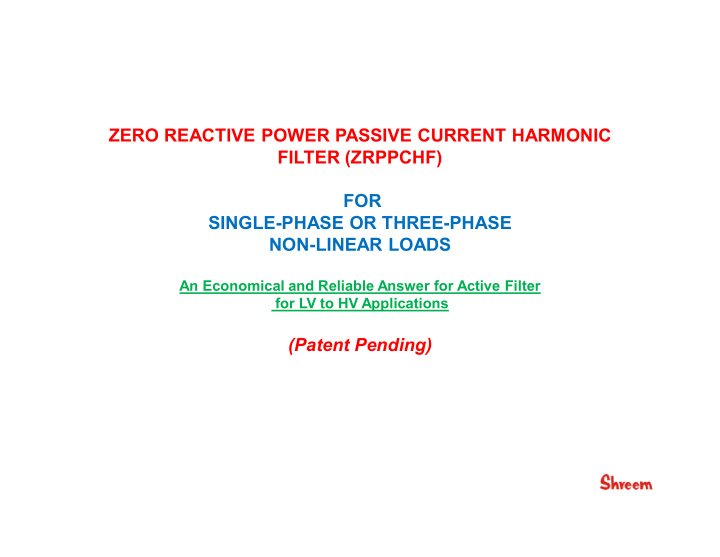



ZERO REACTIVE POWER PASSIVE CURRENT HARMONIC FILTER (ZRPPCHF) FOR SINGLE-PHASE OR THREE-PHASE NON-LINEAR LOADS An Economical and Reliable Answer for Active Filter for LV to HV Applications (Patent Pending)
Reliable and Economical Solution for Supply Current Harmonic Filtering • A Zero Reactive Power Passive Current Harmonic Filter (ZRPPCHF) for current harmonic filtering in supply systems is mathematically formulated, designed, simulated and validated through experimental results. • The ZRPPCHF for current harmonic filtering in supply systems can be mathematically formulated, designed, simulated, and is then implementable for any power system based on the knowledge of its short circuit inductance / capacity and non-linear load. • The ZRPPCHF filters the supply current harmonics and can be designed to achieve a given supply current harmonic distortion (as per IEEE 519 standard or as per user specification) at zero reactive power. • The ZRPPCHF does not require step down transformer for any given system voltage and can be designed for low to high voltage systems. • The ZRPPCHF is free from resonance (filter banks resonating with supply short circuit inductance) and is assured through its mathematical formulation and design. The same also can be checked with modeling and simulation with Matlab / Simulink software (accepted simulation platform all over the world). Even though the ZRPPCHF formulation considers characteristic harmonics (such as 3 rd , 5 th , 7 th , 9 th , 11 th , 13 th ….and so • on ), it can also be designed for non-characteristic harmonics based on the suggested formulation / procedure. The use of Neutral Current Compensator (NCC) allows reduction of 3 rd harmonic current, triplens that is multiple of 3 rd • harmonic and unbalanced component of other harmonics. The ZRPPCHF when used along with NCC reduces the burden of consideration for the reduction of 3 rd harmonic current, triplens that is multiple of 3 rd harmonic and unbalanced component of other harmonics.
Difference between Normal Current Harmonic Filters and ZRPPCHF For designing normal current harmonic filters one requires to know the network short circuit capacity / short circuit impedance and the changing VAr requirement of load. The filters are then designed with specific VAr distribution. It is necessary that a proper Matlab model is developed for the entire system including loads, Filters, and supply with its short circuit impedance and the model is then simulated properly on Simulink platform to get the desired performance of supply current and voltage distortion. Most of the filters do not work at site because systems, as described above, are not properly modeled and simulated. However, it should be noted that the normal harmonic filters require certain amount of VAr capacitors to design them properly. No filters can be designed unless a minimum of 8-10% VAr capacity (compared to load Watts / kW delivery) is used for the filter designs. The patented ZRPPCHF design is based on error estimation of the filter impedances vis-à-vis the short circuit impedance of the supply. Thus, the mathematical formulation is used in such a way that that the filters can be designed with minimum VAr and are able to absorb 95% of the current harmonics flowing in the supply network. To achieve zero reactive power, a certain amount of calculated “inductive” VAr is then added into the system. The entire filter system is then checked for harmonic frequencies to confirm that the filter system remains always inductive and hence can never cause resonance. The filter system then becomes same in performance to that of an “Active Filter”. This aspect of the design has allowed patenting of the ZRPPCHF. It is, hence, performance wise similar to “Active Filter” and allows users to look for a very economical and reliable alternative solution.
Simulation Results Ch1, 3, 4: Three phase supply phase voltages after the short circuit inductance Ch2: Supply “ a ” phase current Ch5: Active power per phase (Approximately 18 kW) Ch6: Diode rectifier and superimposed 3 rd harmonic current as the total per phase load current Ch7: Distortion of current in Ch6 (27%) Ch8: Supply phase current distortion (4.175%) Ch9: Distortion of supply phase voltage after the short circuit inductance (2.2%)
Recommend
More recommend